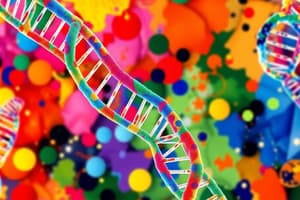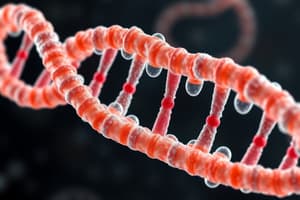Podcast
Questions and Answers
Which type of RNA functions as a transcript copy of a DNA instruction and codes for a protein?
Which type of RNA functions as a transcript copy of a DNA instruction and codes for a protein?
- tRNA
- rRNA
- mRNA (correct)
- sRNA
Which type of RNA transfers amino acids to the ribosome according to the genetic code?
Which type of RNA transfers amino acids to the ribosome according to the genetic code?
- rRNA
- tRNA (correct)
- mRNA and rRNA
- mRNA
Which type of RNA is involved in catalyzing peptide bond formation in ribosomes?
Which type of RNA is involved in catalyzing peptide bond formation in ribosomes?
- tRNA
- mRNA
- sRNA
- rRNA (correct)
What is the primary function of mRNA in protein synthesis?
What is the primary function of mRNA in protein synthesis?
In the genetic code, which type of RNA carries amino acids to the ribosome?
In the genetic code, which type of RNA carries amino acids to the ribosome?
What process forms an RNA polymer by condensing nucleotide monomers?
What process forms an RNA polymer by condensing nucleotide monomers?
Which statement best describes the universality of the genetic code across different species?
Which statement best describes the universality of the genetic code across different species?
What type of RNA is involved in synthesizing proteins and acts as a template for protein production?
What type of RNA is involved in synthesizing proteins and acts as a template for protein production?
What is the primary role of tRNA in protein synthesis?
What is the primary role of tRNA in protein synthesis?
In which cellular structure does rRNA play a significant role in peptide bond formation?
In which cellular structure does rRNA play a significant role in peptide bond formation?
Flashcards are hidden until you start studying
Study Notes
DNA Structure in Prokaryotic and Eukaryotic Cells
- Prokaryotic cells (bacteria) have unpackaged DNA, forming a circular chromosome.
- Eukaryotic cells organize their DNA with histone proteins into a compact structure known as chromatin.
- Eukaryotic DNA is structured into multiple linear chromosomes.
Cell Differentiation and Function
- Cellular differentiation occurs due to the expression of specific DNA sequences.
- Transcription involves RNA transcripts that enable the expression of DNA instructions.
- DNA replication allows genetic information to be inherited across generations.
Cladistics and Ancestry
- Base sequences in nucleic acids can illustrate shared ancestry among organisms.
Nucleic Acids and Their Functions
- Nucleic acids, essential organic biomolecules, store coded instructions for cellular characteristics and act as units of inheritance.
- DNA serves as the genetic material of all living organisms.
- RNA functions as a temporary copy of DNA instructions, facilitating protein production.
Types of Nucleic Acids
- Two major types of nucleic acids: DNA (Deoxyribonucleic Acid) and RNA (Ribonucleic Acid).
- Nucleotides, the building blocks of nucleic acids, consist of:
- A pentose sugar (5-carbon)
- A phosphate group (PO4^3–)
- A nitrogenous base (A, G, C, T/U)
Structure and Function of Nucleotides
- DNA serves as the master copy of genetic instructions and is crucial for inheritance.
- RNA acts as a temporary copy, important for producing proteins based on genetic instructions.
Nucleotide Composition and Arrangement
- The sugar's carbon atoms are numbered clockwise from 1 to 5.
- In a nucleotide, the nitrogenous base connects to the 1’-carbon, while the phosphate group attaches to the 5’-carbon.
Nitrogenous Bases
- Each nucleotide contains a nitrogenous base; these bases are organized into two primary groups.
Studying That Suits You
Use AI to generate personalized quizzes and flashcards to suit your learning preferences.




